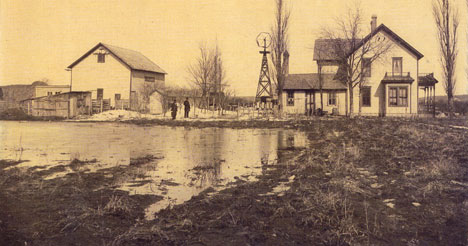FORWARD
The following historical review comprises a mixture of “bits and pieces” of facts, inferences and recollections. Unfortunately, past generations – inclusive of my own family members – seem to have had little interest in organizing and recording genealogical matters. Accordingly, I offer this caveat: Some of the information herein may not be strictly accurate.
BEGINNINGS
The Engell Dairy business took root sometime during the early 1880s (most probably 1882) on a dairy farm at or near Cedar Lake in Minneapolis. The business was established by my grandfather, Lars Andreas Engell [born 1849] and his newly wedded wife Else Perrson Engell [born in 1857]. They were recent immigrants, he from Denmark, she from Sweden. They were married in the U.S.A.. Details are lacking as to actual circumstances, however we do know that they met at the Engell family farm named, Stubbegaard, located on the Danish island of Bomholm. We don’t know what motivated them to emigrate, except, possibly, because they were young and of the adventurous type.

Original Engell Dairy located by Cedar Lake, Minneapolis April 6, 1897
ST. LOUIS PARK
Sometime around the turn of the century the business was moved from the Cedar Lake location to the St. Louis Park location at what is now 4900 Excelsior Boulevard. [The Engells are shown in St. Louis Park in the 1900 Census.] The Rice Sand and Gravel Company was right next door and, later, Arneson’s Landscaping business was established across the street. By this time, the Engell family had grown by six children, listed in the order of their arrival as follows:
AnnaMarie
Alfred Martin
Alma Mathilda
Sigrid Nellie
Esther Eleanor
Reuben Cornelius
The new farm house was relatively large and I was told that it was known as “the half-way house,” because people from outlying communities such as Wayzata, Excelsior etc. would overnight there during horse and buggy shopping excursions to Minneapolis. I don’t know if the house was used for that purpose at any time after my grandparents acquired it.
My recollection of the various buildings comprising the operating part of the farm includes: a screened cottage for summer time use by employees hired on a “board and room” basis, two horse barns, a granary, a tool and spare parts building, several miscellaneous out-buildings, two large ice houses used to store blocks of ice cut from Lake Minnetonka, a chicken coop, a wood shed and, finally, the processing plant.
It is interesting to reflect on how the processing, packaging and delivery of dairy products has evolved over the years. Early on, the dairies delivered milk to customers, door to door, in “bulk” form, using the customers’ own containers. I don’t know when glass bottles – Vi pint, pint and quart bottles – came into common use, probably sometime during the “Teens.” I have a quart size Engell milk bottle dated 1914.
Horse drawn wagons were used and the horses became so accustomed to their respective routes that the driver rarely needed to use the reins. As a matter of fact, at the end of the route, the driver could and many times would take a nap in the wagon on the way back to the dairy. In winter, with snow removal virtually non-existent, sleighs were used in lieu of the wheeled wagons. I used to enjoy riding the runners. Milk delivery trucks began phasing in during the late Twenties and relatively soon thereafter horse and wagon deliveries were phased out completely. And then the Teamsters’ Union came into the picture.
The Union struck The Engell Dairy sometime during the early or mid “Thirties” when my Dad and Uncle refused to authorize them to organize the employees. It was an exciting time for me with Teamster thugs maintaining surveillance over delivery truck movement in and out of the plant, trucks tipped over, trucks driven into Lake Calhoun, tires slashed, drivers beaten up, threats, etc. Eventually, the Teamsters won the battle and doing business with them turned out to be not so bad after all.
Home delivery of dairy products began to phase out with the sale of gallon and half gallon glass bottles of milk at “Milk Stations.” This (I think) began in the late Thirties or early Forties. People obviously liked the idea and the practice spread to the grocery stores. Today, I am unaware of any home delivery of dairy products.
It should be pointed out here that, in my lifetime at least, the Engell Dairy had no cows on the premises. Raw milk was purchased daily, seven days per week, from local farmers. It was tested for butterfat content and paid for on that basis, then pasteurized, quick chilled, bottled, cased and transferred to a cooler and held for distribution to customers the next day. Ancillary products such as cream, butter, buttermilk, cottage cheese, etc. were purchased on a private label basis from the Delano Dairy.
Lars Andreas Engell died in 1933 at the age of 84; Else Perrson Engell died in 1948 at the age of 91. As of this writing, all of their children are likewise deceased. A few cousins are scattered about, but their numbers are thinning out too.
The actual operation of the business fell to the two boys, Alfred and Reuben, probably sometime in the early twenties and continued as a partnership until the business was sold to a Wisconsin based dairy in 1946.
Bohn E. Engell June 18, 2004
Note: My father was Reuben Cornelius Engell. He hated his middle name and never used it. He always signed his name Reuben C. Engell and, if or when pressed to disclose what the “C” stood for, he would answer, “Clifford.”
